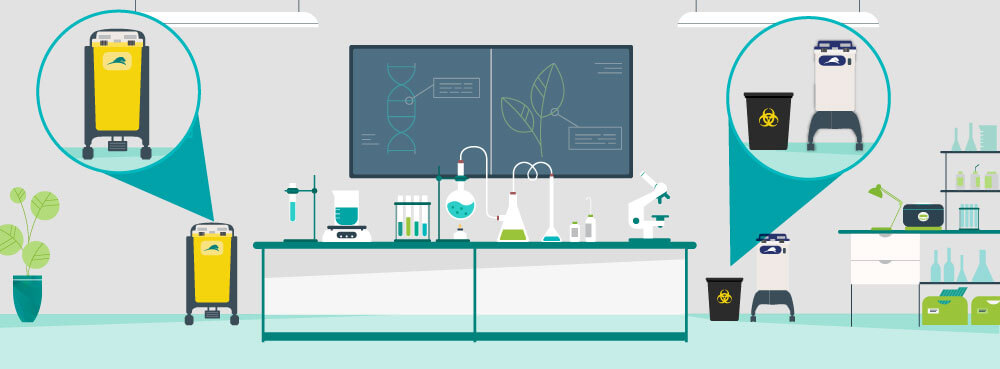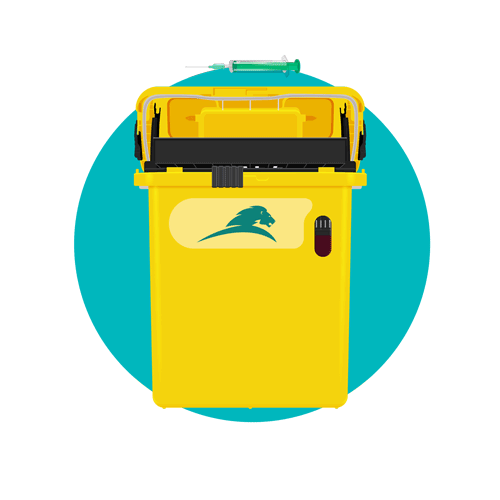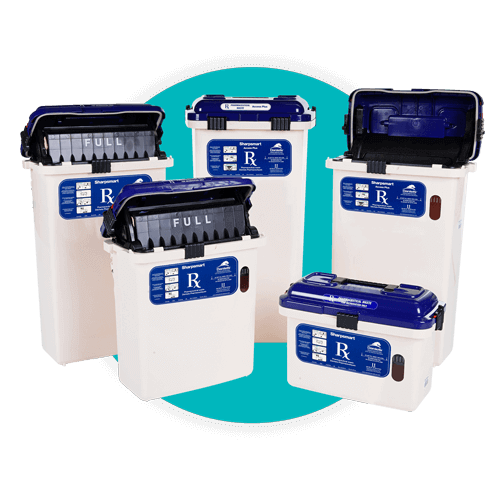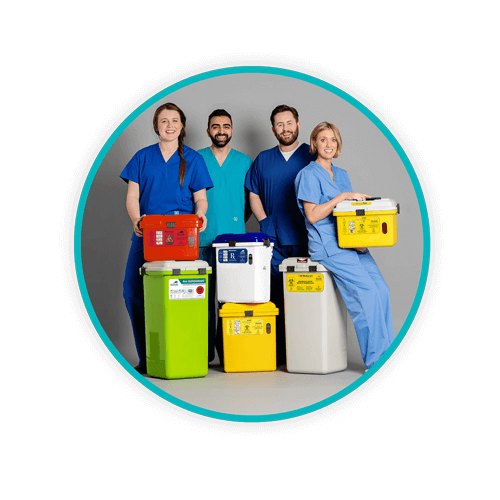Waste Management Solutions for Universities and Labs

Most universities and labs in Canada produce a great deal of potentially biomedical and hazardous waste which they must store and dispose of properly for both safety and to prevent potential compliance issues. Educational institutions offering labs including biology and chemistry as well as research labs can produce enormous volumes of waste that can present risks to both individual health and the environment when not handled properly.
Traditional solutions have often focused on single-use bags and generic solutions that are costly, environmentally unfriendly, and fail to meet the unique needs of these facilities. When it comes to waste management, these facilities have a range of unique needs that demand more than an “off-the-shelf” solution.
With that in mind, let’s review some of the unique challenges these facilities face and how they can meet these challenges in a safe, sustainable, and cost-effective manner.
TOPICS WE WILL COVER:
1 / What are the waste issues universities and laboratories face?
2 / The benefits of Daniels Health
What Are the Waste Issues Universities and Laboratories Face?
Canadian universities and research laboratories generate waste that encompasses a wide range of materials and presents unique hazards for both humans and the environment. This includes large volumes of specialised waste such as biomedical, anatomical, pharmaceutical, needles (sharps), cytotoxic, and more that pose a high risk to human health when improperly managed.
Unfortunately, this wide range of waste streams presents challenges in disposal due to the unique steps that must be taken to dispose of them safely and promptly. Traditionally, universities and laboratories have depended on single-use plastic bags and boxes from several different vendors.
This is not only costly and difficult for students and researchers to understand and comply with but also produces an enormous amount of environmentally unsustainable waste. For instance, the University of Exeter estimated that labs produced approximately 5.5 million tonnes of plastic waste in 2014.
Universities and labs are beginning to recognize the bulk of waste they produce and reevaluate their processes as a result. No two labs have the same needs, but there are safe and effective solutions for every type of waste.
Biomedical Waste Disposal
Biomedical wastes are potentially hazardous for humans and the environment, carrying many bacteria, viruses, and potentially chemical and radioactive pollutants. One report, published in the Canadian Medical Association Journal, found that most provinces have no fixed standards leaving many facilities to figure out on their own how to deal with these materials.
Traditionally, labs use bags and plastic tubs for storing and disposing of infectious wastes. However, these do not provide either a secure or sustainable solution for handling these dangerous materials. Instead, secure and leak-proof containers that can be reused offer a safe and eco-friendly solution that will keep waste out of landfills while reducing labour and disposal costs.
Sharps Disposal
 Sharps produce a unique safety hazard both for infection and injury of students, lab personnel, and others, including custodians. Needlestick injuries are unfortunately common, with more than 69,000 injuries caused by sharps every year across Canada, according to the Workers Health and Safety Centre.
Sharps produce a unique safety hazard both for infection and injury of students, lab personnel, and others, including custodians. Needlestick injuries are unfortunately common, with more than 69,000 injuries caused by sharps every year across Canada, according to the Workers Health and Safety Centre.
Reducing this dangerous phenomenon requires a secure and versatile disposal container that can prevent punctures while being simple and adaptable to different applications. An effective sharps container must be able to be handled while preventing injuries during transport, such as the Sharpsmart, which comes with a suite of features allowing safe and effortless transport. It’s also engineered to hold a greater capacity of sharps through a unique design that allows for efficient stacking, rather than messy bottlenecks being created by this waste.
Anatomical Waste
By its very nature, anatomical waste possesses a significant risk of infection, and its transport and disposal is heavily regulated. This waste encompasses a wide range of types that must be distinguished, handled, and disposed of carefully while adhering to an array of regulations.
This requires a disposal method that makes it easy to distinguish and segregate wastes while providing the correct containment. An effective colour-coded system with clear labelling can provide an ideal solution for the various anatomical wastes generated by many universities and research labs.
Pharmaceutical Disposal
Pharmaceutical disposal provides significant risks of theft and harm to humans and the environment. Improperly secured pharmaceutical disposal can result in tampering or theft, contributing to drug abuse as well as leaks that can cause harm to the environment and public health. One example of this is through improper disposal of antibiotics, which can contribute to antibiotic resistance.
Unfortunately, a study by the National Collaborating Centre for Infectious Diseases found that programs for effective disposal collect only a fraction of the unused and expired pharmaceuticals throughout Canada.
Effective disposal is crucial, and this requires a secure and tamper-proof containment method that is also leakproof. It also requires a disposal partner that can ensure a secure disposal process from pickup to destruction. Daniels’ Pharmasmart provides reusable lockable containers that feature an anti-bounce and gravity-sensitive tray which allows for more waste to safely and securely fit inside each sleek, compact container.
Controlled Substances
 Controlled substances present an added challenge for pharmaceutical disposal. Facilities must make sure they dispose of controlled substances securely. This will ensure they do not harm the environment and that no one can abuse them.
Controlled substances present an added challenge for pharmaceutical disposal. Facilities must make sure they dispose of controlled substances securely. This will ensure they do not harm the environment and that no one can abuse them.
Accomplishing this requires an effective plan for collecting and handling hazardous waste from controlled substances and an effective method for disposal.
Chemical destruction solvents, for instance, render controlled substances unusable, dissolving the active ingredients and neutralising with the use of activated carbon. Locked and secured containers, which can’t simply be carried away are also important for pharmaceutical waste. This makes disposal secure and simple for lab settings which require a fast and effective disposal method.
Cytotoxic Disposal
Cytotoxic waste presents highly unique challenges due to the extremely harmful and toxic nature of cytotoxic chemicals. It is essential to prevent exposure to these carcinogenic chemicals, and this requires a containment method that can handle the many types of waste that can originate when researching or working with chemotherapy treatments.
Whether it is large, small, sharp, or anything else, a cytotoxic waste disposal method must be able to handle it. Traditionally, labs accomplish this through multiple layers of packaging. However, this is wasteful both financially and environmentally.
A durable and reusable container such as Daniel’s Chemosmart container can offer the safety and security this specialised waste requires while reducing costs and environmental impacts.
What Are the Benefits of Daniels?
By choosing Daniels, universities and labs can benefit from working with a single waste management provider that can handle all of their diverse needs. Daniels provides reusable containment systems that eliminate the need for wasteful and costly bags and secondary packaging while providing a simple and safe solution for waste management from customising a waste solution system to supplying the necessary equipment and providing reliable and safe pickup services. Universities and labs can experience a new, streamlined, intelligently-designed approach to waste that solves many of the most cumbersome issues. Begin by reaching out to Daniels to achieve a new level of waste control.
